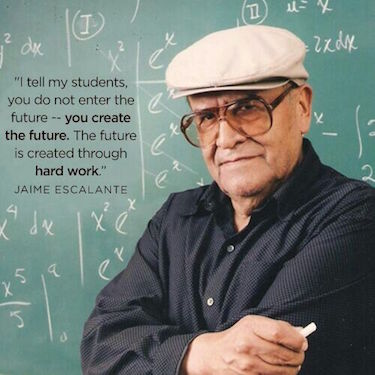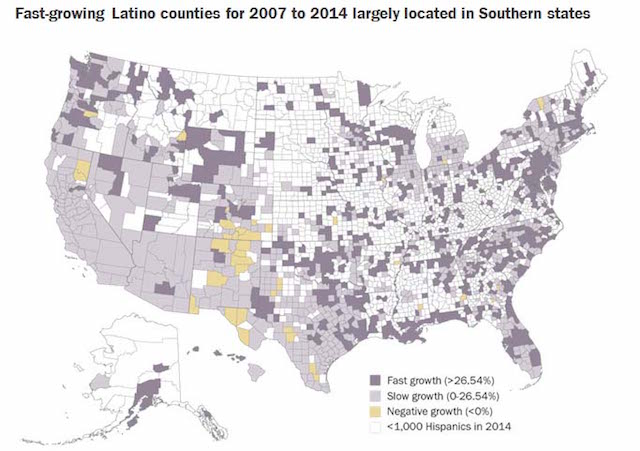Two New Reports Show Why That’s Bad for Both
 Latino teachers are eager to serve as role models and cultural stewards, but they feel their extra work as interpreters for Spanish-speaking families is undervalued, according to a new report from the Education Trust. Many see the additional responsibilities of community outreach as a second job they are expected to perform.
Latino teachers are eager to serve as role models and cultural stewards, but they feel their extra work as interpreters for Spanish-speaking families is undervalued, according to a new report from the Education Trust. Many see the additional responsibilities of community outreach as a second job they are expected to perform.
The report comprises responses from 90 Latino teachers in five states (New Jersey, North Carolina, Florida, Texas, and California) about the complexities of teaching Latino students, as well as their relationships with white colleagues and administrators, and their hopes for professional advancement.
Two themes emerged: the importance of Latino instructors in classrooms where large numbers of students are Latino themselves, and the expectation — often voiced by supervisors — that they act as Spanish-language resources for schools and families.
Many hope to provide an example for students of a first- or second-generation American who has attained advanced degrees and professional success. While stressing the diversity of the Latino experience in America — some respondents were born in the U.S., while others emigrated from Cuba, Mexico, Puerto Rico, the Dominican Republic, and El Salvador — they said they feel a special kinship with students who share their background, particularly at a time of heightened anxiety around deportation and family separation.
Beyond their instructional duties, the teachers stressed their role as “cultural guardians,” introducing their students to Latino history through culturally relevant texts and the selective use of Spanish in class. This is especially tricky, they added, given the requirements of academic standards like the Common Core.
But the added work of acting as a bridge to Latino parents, many of whom struggle to access educational services for their kids without an advocate, can be overwhelming, they said. Schools with only one or two Spanish-speaking staff members sometimes rely on them to mediate between parents and teachers, or even to translate districtwide curricular materials.
“I think of even student-teacher conferences [that leave] parents and families feeling unwelcome … and no one’s going to [help] the families that they can’t communicate with,” one teacher said. “Suddenly, I’m in charge of every Hispanic student that we have in sixth grade, which is the majority of all of our students, and it’s an extra job on top of my job to communicate with all those families.”
The pressure of acting as part-time interpreters and school ambassadors is widely shared, in part because there are so few Latino teachers. While roughly one-quarter of American K-12 students are Latino, less than 10 percent of teachers are. Those gaps are most acute in border-adjacent states like Texas and California — but the counties experiencing the fastest Latino population growth are mostly found in the Pacific Northwest, the mid-Atlantic states, and the South.
 Research has shown that early exposure to a teacher from the same racial or ethnic group can lower dropout rates and boost educational attainment among minority students. Hundreds of districts are searching for Latino teachers — especially men — to keep up with the surge in Latino students. (The Education Trust’s respondents were almost 90 percent female, a lopsided composition that points to the difficulty of attracting young Latino men to the profession.)
Research has shown that early exposure to a teacher from the same racial or ethnic group can lower dropout rates and boost educational attainment among minority students. Hundreds of districts are searching for Latino teachers — especially men — to keep up with the surge in Latino students. (The Education Trust’s respondents were almost 90 percent female, a lopsided composition that points to the difficulty of attracting young Latino men to the profession.)
Helpfully, the Center for American Progress has released a research brief offering three recommendations to widen the talent pipeline.
First, it advises Congress to pass a clean Dream Act protecting immigrants currently in danger of losing their protections under the Obama administration’s Deferred Action for Childhood Arrivals (DACA) program. Of nearly 700,000 young people covered under DACA, about 20,000 work as teachers. Many are college-educated and bilingual; given the shortage of qualified replacements, deporting so many would be a significant step backward.
Equally important, the authors argue, are financial incentives to help students pursue teaching degrees and earn a license. Latinos currently lag behind all other ethnic groups in college graduation, and the Trump administration’s proposed budget cuts to grant aid and federal loan programs could push postsecondary education even further out of reach for promising low-income students. According to new research from the Brookings Institution, rates of both student borrowing and default are nearly twice as high for Latino students as for whites; making college more affordable could guide many to careers in teaching.
Finally, the brief points to the success of alternative teacher certification programs like Teach for America and the National Center for Teacher Residencies, as well as local grow-your-own programs in Oregon and Washington. All have fostered strong pools of minority talent, but the grow-your-own model — which typically focuses on credentialing bilingual candidates already working in classrooms, like teaching assistants and paraprofessionals — could be particularly attractive to localities.
Researched and written by Kevin Mahnken and published on The 74 ~ March 12, 2018.
 FAIR USE NOTICE: This site contains copyrighted material the use of which has not always been specifically authorized by the copyright owner. We are making such material available in our efforts to advance understanding of environmental, political, human rights, economic, democracy, scientific, and social justice issues, etc. We believe this constitutes a ‘fair use’ of any such copyrighted material as provided for in section 107 of the US Copyright Law. In accordance with Title 17 U. S. C. Section 107, the material on this site is distributed without profit to those who have expressed a prior interest in receiving the included information for research and educational purposes. For more information go to: http://www.law.cornell.edu/uscode/17/107.shtml
FAIR USE NOTICE: This site contains copyrighted material the use of which has not always been specifically authorized by the copyright owner. We are making such material available in our efforts to advance understanding of environmental, political, human rights, economic, democracy, scientific, and social justice issues, etc. We believe this constitutes a ‘fair use’ of any such copyrighted material as provided for in section 107 of the US Copyright Law. In accordance with Title 17 U. S. C. Section 107, the material on this site is distributed without profit to those who have expressed a prior interest in receiving the included information for research and educational purposes. For more information go to: http://www.law.cornell.edu/uscode/17/107.shtml

My wife was born of Ukraine heritage in Germany at the end of WWII. At the age of three her family migrated to Venezuela where she learned the Spanish language and the language of her heritage as well. Later in life she went back to school to earn her Teaching Degree and has been an ESL (English Second Language) teacher for many years. She also came to this country in 1961 at the age of 16 – and guess what? There was no one to teach her a new language (English). You were thrown into the system, and you learned pretty damned quickly on your own. Not today my friends and readers. It seems to be the job of the American taxpayer to insure that WE are responsible for furnishing any illegal invader, immigrant or refugee whatever it takes to “make them feel welcome.”
There is one problem with all of this – a large percentage of these new “students” could not care less. Many just don’t want to be in class – they would rather be on the streets peddling drugs or raising havoc. Is it true for all of them? Of course not. There are those who truly want to grow and become a part of something special – but what is special to them may not be of benefit to the nation nor the community.
If one wishes to become a part of what this nation has so graciously provided – then immerse ones self into the school, the community (as a whole) AND the language. Why does the American Education system have to provide for everyone of a different race, creed, religion, sexual preference or language? Take responsibility for what YOU want to be (the rest of us have had to do it).
I am sorry (not) that there are not enough of your “own kind” here to teach you. If you and your family have come here – become a part of it – it’s up to you.
PS: My wife retired some 7 years ago, but remains active within the system as a full time substitute teacher. ~ Ed.
“I tell my students, you do not enter the future – you create the future. The future is achieved through hard work.” ~ Jaime Escalante